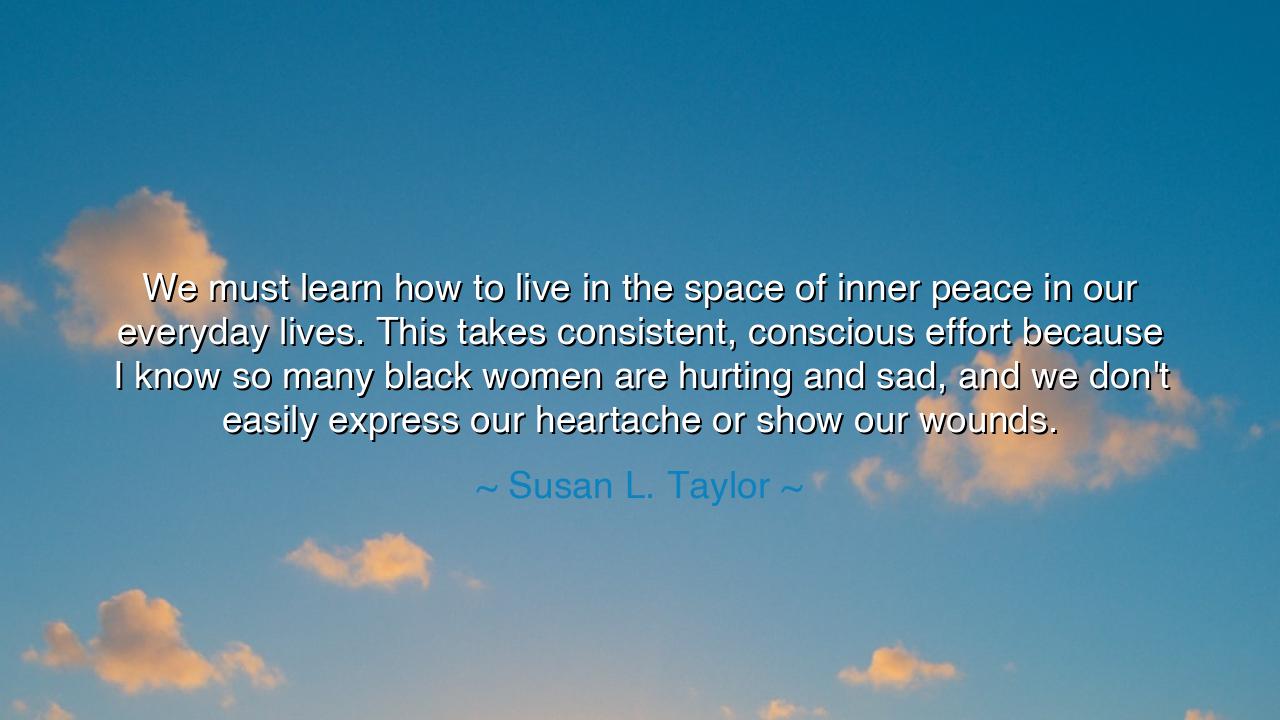
We must learn how to live in the space of inner peace in our
We must learn how to live in the space of inner peace in our everyday lives. This takes consistent, conscious effort because I know so many black women are hurting and sad, and we don't easily express our heartache or show our wounds.






The words of Susan L. Taylor come forth with the solemnity of a prophet and the tenderness of a healer: “We must learn how to live in the space of inner peace in our everyday lives. This takes consistent, conscious effort because I know so many black women are hurting and sad, and we don't easily express our heartache or show our wounds.” Within these lines lies both a lament and a command. She names the silent suffering of women who carry burdens unseen, and she offers the path of deliverance—not in wealth or fame, but in the cultivation of inner peace.
The origin of this quote lies in Taylor’s lifelong work as a writer, editor, and voice of empowerment, especially through her years at Essence magazine. She bore witness to the struggles of African American women—women who endured hardship yet pressed forward with dignity, often concealing pain behind unshakable resilience. Her words are rooted in that truth: that strength without rest becomes weariness, and dignity without healing becomes despair. Thus she exhorts us to seek a sanctuary within, a place of stillness that no hardship can shatter.
Her teaching recalls the wisdom of the Stoic philosophers of old, who urged men and women alike to find tranquility not in the tumult of the world, but in the fortress of the soul. Marcus Aurelius, emperor and philosopher, surrounded by wars and betrayals, wrote to himself: “The soul becomes dyed with the color of its thoughts.” In the same spirit, Taylor declares that peace is not given—it must be practiced, cultivated, defended daily. For storms will always come, but a soul anchored in inner peace does not drown.
She speaks also of the silence of suffering: “we don’t easily express our heartache or show our wounds.” Here she names a truth carried through generations—that many women, especially black women, have been taught to be pillars of strength, to endure silently, to smile while broken. Yet unspoken sorrow festers. By naming this, Taylor breaks the silence and urges a new path: that true strength is not to hide wounds, but to heal them, and that healing begins with the courage to dwell in peace rather than in constant battle.
History offers us examples of such endurance and the price it exacts. Think of Harriet Tubman, who bore unspeakable hardship, scars from slavery, and the weight of leading others to freedom. She rarely spoke of her own suffering, yet it lived in her body and spirit. Her greatness was forged in struggle, but imagine, too, the cost of carrying pain without rest. Taylor’s words remind us that even the strongest deserve healing, that survival alone is not enough—we must find ways to be whole.
The lesson here is clear: inner peace is not luxury, but necessity. It is not found by chance, but by daily, conscious practice. Meditation, prayer, journaling, honest conversation, rest—these are the sacred tools that build the sanctuary within. And for those who suffer silently, it is an act of courage to seek peace, to express pain, and to tend the wound rather than conceal it. This is not weakness; it is the deepest form of wisdom.
Practically, Taylor’s words call each of us to action. Create daily moments of stillness, however brief. Breathe, reflect, and listen to the whisper of your own soul. Share your pain with trusted friends instead of burying it. Encourage others to do the same. And if you see someone carrying silent sorrow, offer compassion without judgment. In this way, the healing of individuals becomes the healing of communities.
Thus, Susan L. Taylor’s words are not only counsel but prophecy: without inner peace, the soul perishes in silence; with it, the soul flourishes despite the storm. She speaks to black women, but her wisdom belongs to all humanity. Let us honor her teaching by building sanctuaries within ourselves, and by helping others find theirs. For in a world of noise, wounds, and endless struggle, inner peace is the greatest act of resistance, and the highest form of strength.






AAdministratorAdministrator
Welcome, honored guests. Please leave a comment, we will respond soon